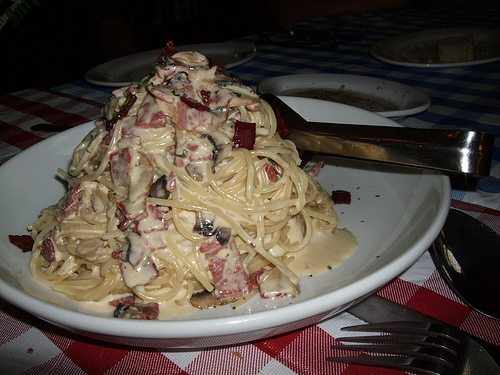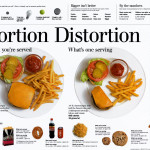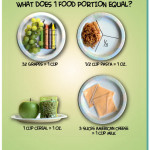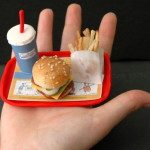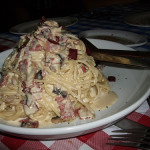Simple enough question, so it should be easy to answer. Sadly not, and possibly dependent on what you’re used to, though it begs the question of what we expect and what we consider to be acceptable when it comes to dinnertime. So let’s start with a dictionary definition, less the irrelevant bits:
por·tion (pôr sh
sh n, p
n, p r
r -) n.
-) n.
Except when you’re feeding yourself, a helping may vary according to how hungry you are, but if you’re dining out it may be a total lottery. If you eat every day in top notch nouvelle cuisine restaurants, you might consider the norm to be tiny heaps of stuff in the middle of a gleaming white plate, and to leave said establishment just as hungry as you entered it.
If it’s part of a 7-course tasting menu, small portions might be acceptable and leave you satisfied, but taken individually from the carte you might have a starter, a main and a dessert, then leave feeling so hungry you want to stop off for fish and chips on the way home. That is clearly unacceptable, no matter how pretty the plates look.
On the other hand, you may frequent Chinese buffet eateries and be more familiar with the concept of stuffing your face with as many piled-high plates as you can physically cram down your oesophagus – never mind the quality, feel the width!
From then perspective of the restauranteur, if it is good fresh food made from expensive ingredients, you don’t want to be giving away more than is strictly necessary, certainly not enough for people to leave it, and you also want to encourage the punters to leave room for side dishes, desserts and other profitable additions to the bill. In London, many try to get away with portions that clearly fall below expectations and leave the diner feeling hungry on the way out – or maybe that is a good thing?
However, if you overdo that there will inevitably be complaints that the restaurant offers poor value for money – even if the food in question would overface the diners. America is the prime case in point, but there are plenty more. There was an occasion in Florida when Jean, the kids and I went to an Italian restaurant. Jean announced she was not very hungry so would only eat bruschetta and a salad. Far from being the delicate rounds of toasted bread topped with chopped tomatoes, the “bruschetta” was actually a baguette cut in two and loaded with ingredients. The “salad” came in a small bucket and was topped with a pound and a half of sliced meats.
Everywhere you go in the States, restaurant food comes in portions that are plainly absurd, yet the cultural expectation is such that plates must be loaded high. Whatever problems we have this side of the pond with obesity are nothing to the epidemic over there, yet restaurants feel unable to reduce portion size for fear of losing punters, some of whom took the remainder home in “doggy bags”.
Ever see Man vs Food on the Food Network? This is where food ceases to be nourishment and becomes a challenge. Eating impossibly superhuman meals, or in some cases dishes made with chillis so hot that you break into a sweat just looking at them. Why, you might reasonably ask, do people push themselves? To go on a wall of fame and get their food free? It certainly doesn’t improve their health any. For the restaurant it garners publicity and attracts more nuts to take the challenge.
Nor is it particular to the USA. I have pictures from the “death” restaurant in Budapest, where very good food at not especially cheap prices was served to Lindsey, Adam and myself. The kids got through possibly a quarter of their plates, no more than half. Even I could not finish, and that is saying something! The UK is not exempt, though.
Buffet restaurants have pandered to the desire to overeat and have more plates of food than you actually need or want, just so you can try everything on offer. I’ve been at restaurants where people return time and again to order platefuls of food, and you can only surmise there are three possible reasons for that: they have large appetites that can only be satisfied by eating and eating and eating; that it is the only way to achieve value for money; or that they have a psychological disorder that means they continue to eat when not hungry. Greed and gluttony tempt us constantly, which is why there is a global obesity crisis and avoidable heart disease – while millions starve.
So where is the happy medium? If you were to serve a roast chicken to a table of four diners, the probability is that one might be happy with a couple of slices of breast meat, one or two might like a drumstick and a thigh, and so on… the chicken would be eaten but in the quantities that suit the individual rather than any imposed limits.
For restaurants, it might work well to serve a moderate portion but then offer a second helping for those who are not satisfied, with some justification. After all, that is what mother would have offered! Or at least be flexible and give what people want and need, not what you think they want or the minimum you can get away with giving them? Why not ask people whether they want small, medium or large portions?
Stop Press: At the other extreme…. don’t try this at home!!!

